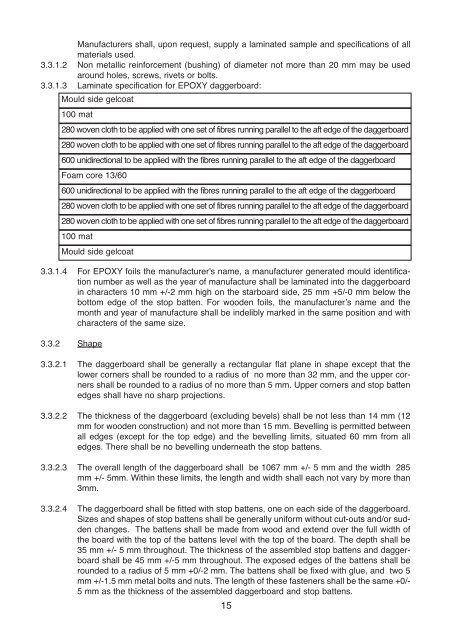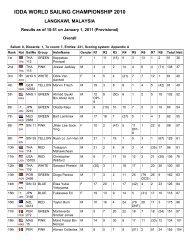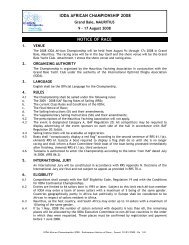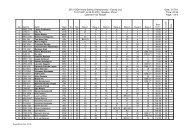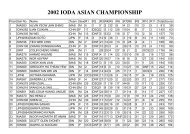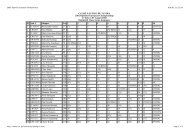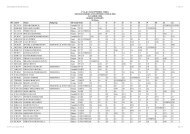2011 INTERNATIONAL OPTIMIST CLASS RULES
2011 INTERNATIONAL OPTIMIST CLASS RULES
2011 INTERNATIONAL OPTIMIST CLASS RULES
You also want an ePaper? Increase the reach of your titles
YUMPU automatically turns print PDFs into web optimized ePapers that Google loves.
Manufacturers shall, upon request, supply a laminated sample and specifications of all<br />
materials used.<br />
3.3.1.2 Non metallic reinforcement (bushing) of diameter not more than 20 mm may be used<br />
around holes, screws, rivets or bolts.<br />
3.3.1.3 Laminate specification for EPOXY daggerboard:<br />
Mould side gelcoat<br />
100 mat<br />
280 woven cloth to be applied with one set of fibres running parallel to the aft edge of the daggerboard<br />
280 woven cloth to be applied with one set of fibres running parallel to the aft edge of the daggerboard<br />
600 unidirectional to be applied with the fibres running parallel to the aft edge of the daggerboard<br />
Foam core 13/60<br />
600 unidirectional to be applied with the fibres running parallel to the aft edge of the daggerboard<br />
280 woven cloth to be applied with one set of fibres running parallel to the aft edge of the daggerboard<br />
280 woven cloth to be applied with one set of fibres running parallel to the aft edge of the daggerboard<br />
100 mat<br />
Mould side gelcoat<br />
3.3.1.4 For EPOXY foils the manufacturer's name, a manufacturer generated mould identification<br />
number as well as the year of manufacture shall be laminated into the daggerboard<br />
in characters 10 mm +/-2 mm high on the starboard side, 25 mm +5/-0 mm below the<br />
bottom edge of the stop batten. For wooden foils, the manufacturerʼs name and the<br />
month and year of manufacture shall be indelibly marked in the same position and with<br />
characters of the same size.<br />
3.3.2 Shape<br />
3.3.2.1 The daggerboard shall be generally a rectangular flat plane in shape except that the<br />
lower corners shall be rounded to a radius of no more than 32 mm, and the upper corners<br />
shall be rounded to a radius of no more than 5 mm. Upper corners and stop batten<br />
edges shall have no sharp projections.<br />
3.3.2.2 The thickness of the daggerboard (excluding bevels) shall be not less than 14 mm (12<br />
mm for wooden construction) and not more than 15 mm. Bevelling is permitted between<br />
all edges (except for the top edge) and the bevelling limits, situated 60 mm from all<br />
edges. There shall be no bevelling underneath the stop battens.<br />
3.3.2.3 The overall length of the daggerboard shall be 1067 mm +/- 5 mm and the width 285<br />
mm +/- 5mm. Within these limits, the length and width shall each not vary by more than<br />
3mm.<br />
3.3.2.4 The daggerboard shall be fitted with stop battens, one on each side of the daggerboard.<br />
Sizes and shapes of stop battens shall be generally uniform without cut-outs and/or sudden<br />
changes. The battens shall be made from wood and extend over the full width of<br />
the board with the top of the battens level with the top of the board. The depth shall be<br />
35 mm +/- 5 mm throughout. The thickness of the assembled stop battens and daggerboard<br />
shall be 45 mm +/-5 mm throughout. The exposed edges of the battens shall be<br />
rounded to a radius of 5 mm +0/-2 mm. The battens shall be fixed with glue, and two 5<br />
mm +/-1.5 mm metal bolts and nuts. The length of these fasteners shall be the same +0/-<br />
5 mm as the thickness of the assembled daggerboard and stop battens.<br />
15


